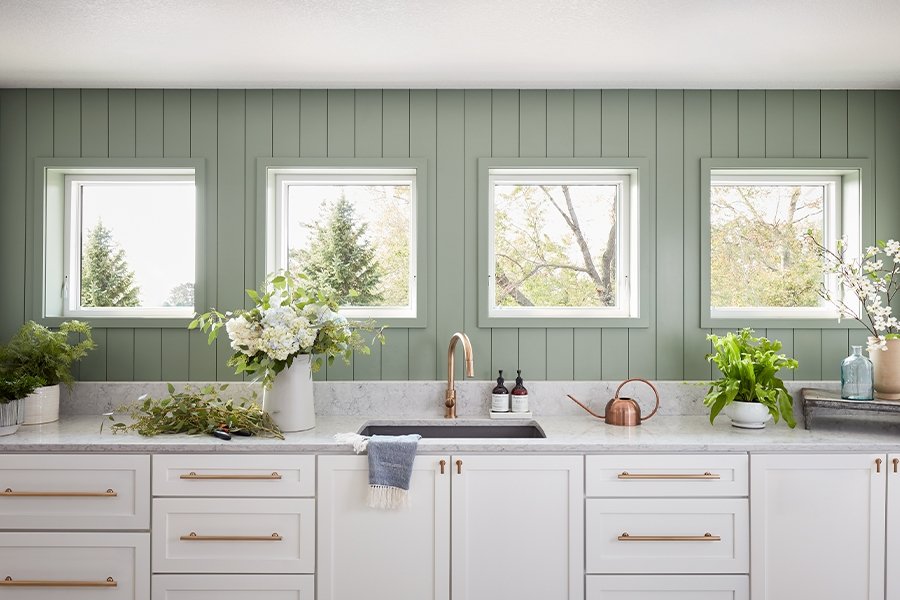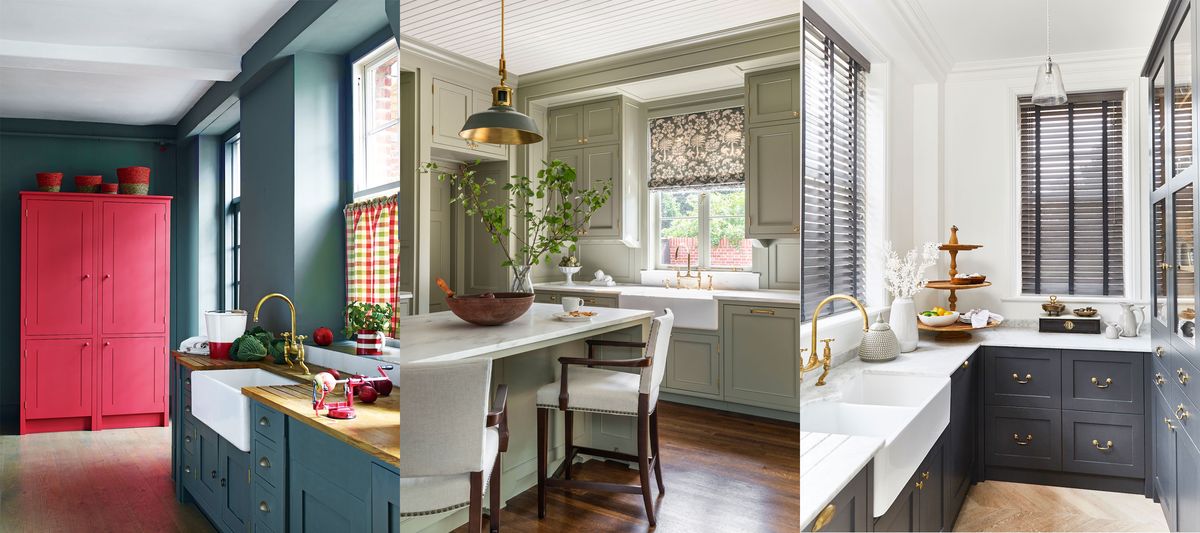Advantages and Disadvantages of Kitchen Cabinets Over a Sink Window: Kitchen Cabinets Over Sink Window

Installing cabinets over a sink window can be a stylish and functional design choice for your kitchen. However, it’s important to weigh the advantages and disadvantages before making a decision.
Advantages of Kitchen Cabinets Over a Sink Window
Having cabinets over a sink window offers several benefits, making it a desirable option for many homeowners.
- Natural Light: A sink window allows natural light to flood the kitchen, creating a brighter and more inviting atmosphere. This can be especially beneficial for kitchens with limited natural light.
- Ventilation: The window provides ventilation, allowing fresh air to circulate and reducing humidity, which is crucial in a kitchen where cooking often occurs.
- Aesthetic Appeal: A sink window can add a touch of elegance and sophistication to the kitchen. It can also provide a beautiful view of the outdoors, making the kitchen feel more connected to the surrounding environment.
Disadvantages of Kitchen Cabinets Over a Sink Window
While the advantages are numerous, there are also some potential drawbacks to consider.
- Potential for Water Damage: Water splashes from the sink can damage the cabinets over time, especially if they are not properly sealed or protected. This can lead to warping, mold growth, and other problems.
- Limited Storage Space: The window itself takes up space, reducing the amount of storage available in the cabinets above. This can be a concern for kitchens with limited storage space.
- Increased Cleaning Requirements: The cabinets over the sink window may require more frequent cleaning, as they are more exposed to splashes and spills.
Comparison of Pros and Cons
Ultimately, the decision of whether or not to install cabinets over a sink window depends on your individual needs and preferences. Consider the advantages and disadvantages carefully before making a decision. If you value natural light and ventilation, and you have sufficient storage space elsewhere in your kitchen, this design could be a great choice for you. However, if you are concerned about potential water damage or limited storage, you may want to consider other options.
Design Considerations for Kitchen Cabinets Over a Sink Window

Installing cabinets over a sink window presents a unique design challenge, requiring careful planning to maximize storage, functionality, and aesthetics. This section will explore essential design considerations for successfully integrating cabinets over a sink window.
Cabinet Styles and Materials
The style and material of your cabinets should complement the overall design of your kitchen. Consider these options:
- Traditional Cabinets: Traditional cabinets with raised panels, ornate hardware, and a warm wood finish create a classic and timeless look. Oak, cherry, and maple are popular wood choices for traditional cabinets.
- Modern Cabinets: Modern cabinets feature clean lines, flat panels, and minimalist hardware. They often come in high-gloss finishes, such as white or black lacquer, or in natural wood veneers.
- Contemporary Cabinets: Contemporary cabinets offer a blend of traditional and modern elements. They may feature sleek lines, simple hardware, and a mix of wood and other materials, such as metal or glass.
Window Type and Size
The type and size of your window should complement the cabinets and the overall design of your kitchen.
- Window Types: Consider using casement windows, awning windows, or double-hung windows, which can be easily opened and closed for ventilation and natural light. Sliding windows may not be as practical for this application.
- Window Size: The size of the window should be proportional to the size of the cabinets and the overall kitchen space. A large window will provide more natural light but may limit cabinet space. A smaller window may offer more storage but may restrict natural light.
Maximizing Storage Space, Kitchen cabinets over sink window
To maximize storage space while maintaining functionality, consider these tips:
- Shallow Cabinets: Use shallow cabinets above the sink to avoid obstructing the window view and to make it easier to access items.
- Open Shelving: Consider using open shelving for frequently used items, such as spices or dishes. This will make them easier to access and add a visual element to the space.
- Pull-Out Drawers: Install pull-out drawers for easy access to items stored in the cabinets.
- Vertical Storage: Utilize vertical storage solutions, such as tiered shelves or stacking organizers, to maximize space.
- Corner Cabinets: Optimize corner cabinets with lazy Susan organizers for easy access to items.
Aesthetics
Consider these design tips to enhance the aesthetic appeal of your kitchen cabinets over a sink window:
- Matching Finishes: Choose cabinets with finishes that complement the window trim, countertops, and other kitchen fixtures.
- Lighting: Adequate lighting is essential for both functionality and aesthetics. Install under-cabinet lighting to illuminate the work area and highlight the cabinets.
- Backsplash: A stylish backsplash can enhance the overall design of the space and protect the wall behind the sink.
Practical Considerations for Kitchen Cabinets Over a Sink Window

Installing cabinets over a sink window can add a unique aesthetic to your kitchen, but it’s essential to consider the practical implications before making a decision. While this design choice can enhance natural light and ventilation, it also introduces potential challenges that need to be addressed.
Potential for Water Damage and Prevention
Water damage is a significant concern when installing cabinets over a sink window. The proximity of the window to the sink creates a potential pathway for water to seep into the cabinet, causing damage to the structure and contents.
To mitigate this risk, several preventive measures can be taken:
- Install a backsplash: A backsplash extending beyond the cabinet base will create a barrier, preventing water from reaching the cabinet’s underside.
- Use waterproof materials: Opt for cabinets made from moisture-resistant materials, such as stainless steel, solid wood with a water-resistant finish, or moisture-resistant plywood.
- Proper ventilation: Adequate ventilation will help to prevent moisture buildup within the cabinet. Install a small vent or fan to circulate air and remove excess humidity.
- Careful cleaning: Regularly wipe down the window sill and the area around the sink to prevent water from accumulating and seeping into the cabinet.
Cleaning and Maintaining Cabinets Over a Window
Cleaning and maintaining cabinets over a sink window can be more challenging than standard cabinets. The window creates an additional surface that needs to be cleaned, and the proximity of the sink increases the risk of spills and splashes.
Here are some tips for effective cleaning and maintenance:
- Choose easy-to-clean materials: Select cabinet finishes that are easy to wipe down, such as painted surfaces, laminate, or stainless steel. Avoid materials that are porous or prone to staining, such as natural wood with an unfinished or unsealed surface.
- Install a pull-out shelf: This will make it easier to access and clean the area behind the sink without having to climb on a step stool or reach over the window.
- Regular cleaning: Clean the cabinets and the window regularly to prevent dirt and grime buildup. A damp cloth and mild cleaning solution are usually sufficient.
Impact on Kitchen Ventilation and Ensuring Proper Airflow
Installing cabinets over a sink window can affect kitchen ventilation, potentially hindering airflow and increasing the risk of moisture buildup. Proper ventilation is crucial for maintaining a healthy and comfortable kitchen environment.
Here are some strategies to ensure adequate ventilation:
- Window size and placement: Consider the size and placement of the window. A large window with adequate clearance from the cabinet will allow for better airflow.
- Exhaust fan: Install a powerful exhaust fan to remove moisture and cooking odors from the kitchen. The fan should be located above the stovetop or range and vented to the exterior of the house.
- Cabinet design: Choose cabinet designs that allow for sufficient airflow. For example, open shelving or cabinets with louvered doors can promote better ventilation.
Kitchen cabinets over sink window – Kitchen cabinets over a sink window can create a beautiful and functional space, but it can also be a design challenge. One way to tackle this is by using a two-color scheme for your cabinets. This allows you to create visual interest and separate different zones within your kitchen.
For instance, you could use a lighter color for the cabinets above the window, creating a sense of airiness and openness, and a darker color for the lower cabinets, adding a grounding element. You can learn more about the exciting possibilities of two color kitchen cabinets to see how they can transform your kitchen.
When done right, the two-tone cabinets can help accentuate the natural light streaming through your window, adding a unique charm to your kitchen design.
You know, that whole kitchen cabinet-over-sink-window thing is a design choice that always gets me thinking. It’s all about maximizing natural light, but sometimes I wonder if it’s a bit impractical. After all, if you’re looking for a place that’s bright and airy, maybe you should consider checking out some one bedroom apartments in Huntersville, NC.
They often have a lot of natural light, and you might find that a little more practical for your daily routine. But hey, if you’re going for that dramatic kitchen statement, cabinets over the sink window can be pretty stunning.